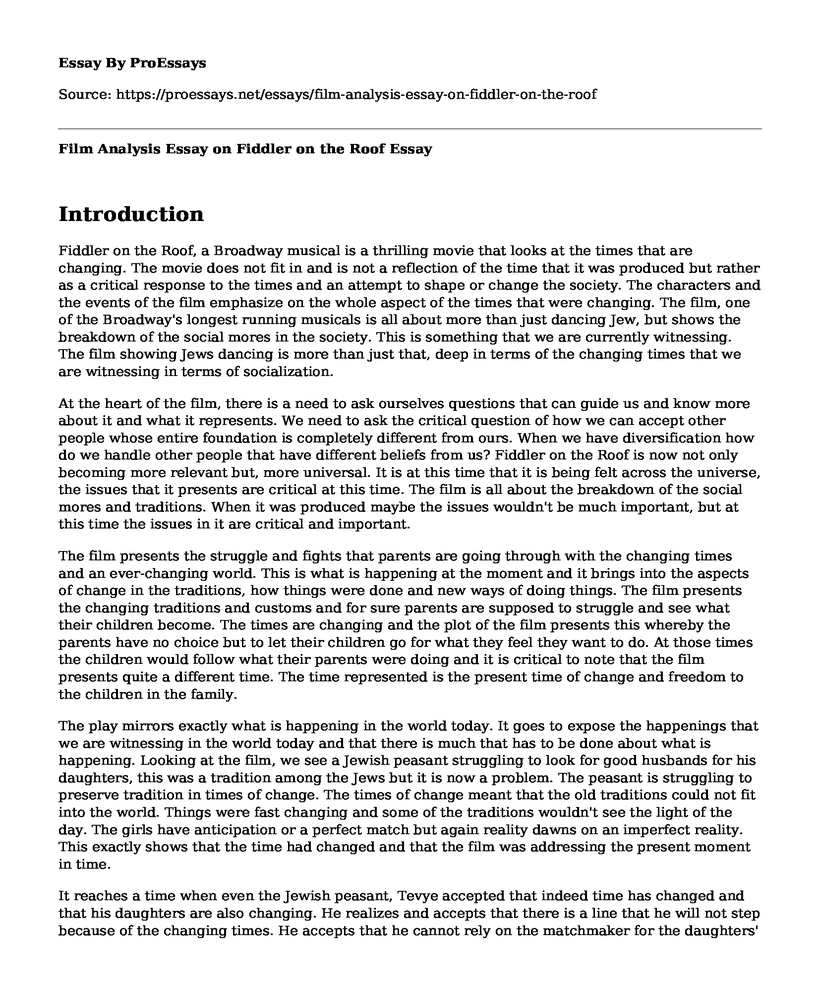Introduction
Fiddler on the Roof, a Broadway musical is a thrilling movie that looks at the times that are changing. The movie does not fit in and is not a reflection of the time that it was produced but rather as a critical response to the times and an attempt to shape or change the society. The characters and the events of the film emphasize on the whole aspect of the times that were changing. The film, one of the Broadway's longest running musicals is all about more than just dancing Jew, but shows the breakdown of the social mores in the society. This is something that we are currently witnessing. The film showing Jews dancing is more than just that, deep in terms of the changing times that we are witnessing in terms of socialization.
At the heart of the film, there is a need to ask ourselves questions that can guide us and know more about it and what it represents. We need to ask the critical question of how we can accept other people whose entire foundation is completely different from ours. When we have diversification how do we handle other people that have different beliefs from us? Fiddler on the Roof is now not only becoming more relevant but, more universal. It is at this time that it is being felt across the universe, the issues that it presents are critical at this time. The film is all about the breakdown of the social mores and traditions. When it was produced maybe the issues wouldn't be much important, but at this time the issues in it are critical and important.
The film presents the struggle and fights that parents are going through with the changing times and an ever-changing world. This is what is happening at the moment and it brings into the aspects of change in the traditions, how things were done and new ways of doing things. The film presents the changing traditions and customs and for sure parents are supposed to struggle and see what their children become. The times are changing and the plot of the film presents this whereby the parents have no choice but to let their children go for what they feel they want to do. At those times the children would follow what their parents were doing and it is critical to note that the film presents quite a different time. The time represented is the present time of change and freedom to the children in the family.
The play mirrors exactly what is happening in the world today. It goes to expose the happenings that we are witnessing in the world today and that there is much that has to be done about what is happening. Looking at the film, we see a Jewish peasant struggling to look for good husbands for his daughters, this was a tradition among the Jews but it is now a problem. The peasant is struggling to preserve tradition in times of change. The times of change meant that the old traditions could not fit into the world. Things were fast changing and some of the traditions wouldn't see the light of the day. The girls have anticipation or a perfect match but again reality dawns on an imperfect reality. This exactly shows that the time had changed and that the film was addressing the present moment in time.
It reaches a time when even the Jewish peasant, Tevye accepted that indeed time has changed and that his daughters are also changing. He realizes and accepts that there is a line that he will not step because of the changing times. He accepts that he cannot rely on the matchmaker for the daughters' marriage but rather the daughters will have the will and freedom to choose for themselves. It, therefore, means that they have the freedom and they present their love to their father. Even when Chava falls in love with a Russian soldier, the father becomes heartbroken and this is because of the rift that was there with tradition. The father cannot help but feel heartbroken because of this but he has no choice other than to accept although it's not his desire. This goes further to cement the notion of change that is being witnessed all over. The times have changed and that it is critical some of the traditions are left behind and not carried on. Tevye tries so hard to stick to tradition; this is seen especially as he is trying to marry off his daughters(Fiddler on the Roof). However, his family sticks to different ideas. It, therefore, means that he has to change his rigid way of thinking or he risks making his daughters unhappy. His inner battles are what makes the show interesting and also shows the changes that were occurring in society.
Conclusion
We can conclude by saying that the film, Fiddler on the Roof reflects on the time when it was produced but rather was critical on the changing times that were being witnessed. The film was a critical response to the times and an attempt to shape or change the society.
Work Cited
Fiddler on the Roof. Norman Jewison. The Mirisch Production Company. November 3, 1971
Cite this page
Film Analysis Essay on Fiddler on the Roof . (2022, Oct 15). Retrieved from https://proessays.net/essays/film-analysis-essay-on-fiddler-on-the-roof
If you are the original author of this essay and no longer wish to have it published on the ProEssays website, please click below to request its removal:
- Biggest Story in the Media - Essay Example
- Analytical Reference in Hip-Hop Culture Essay
- Compare and Contrast Essay on "In the Realm of Senses" and "Maborosi"
- Films Analysis Essay on The Battleship Potemkin and Triumph of the Will
- Sharpening Writing Skills: A Course for Success - Essay Sample
- Doping Scandal Exposes Russia's State-Sponsored Olympic Program: Essay Sample on Icarus Documentary
- Modern Table: Analyzing an Expressive Performance of 'Darkness PooBa' - Essay Sample







